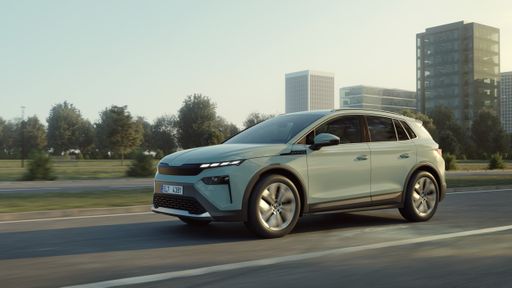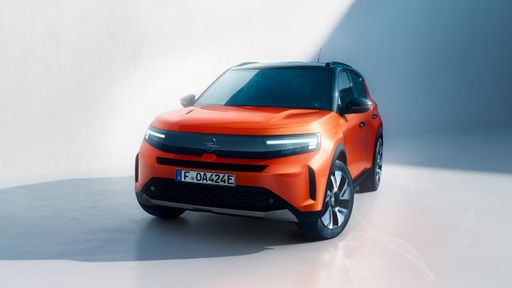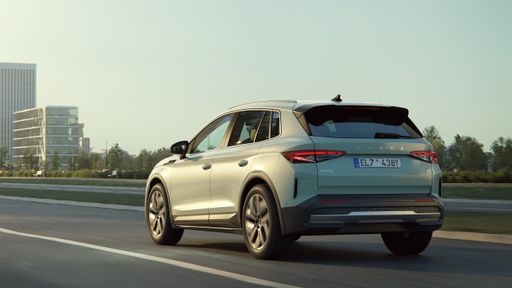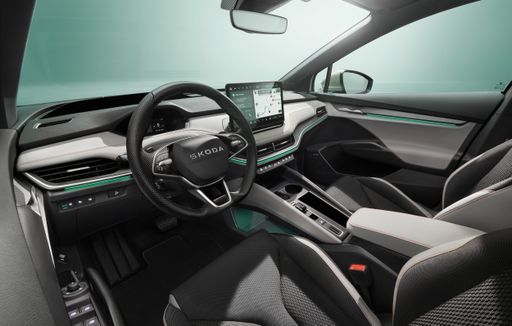When it comes to the burgeoning segment of electric and hybrid vehicles, two contenders have emerged: the Opel Frontera and the Skoda Elroq. Both vehicles promise a blend of efficiency, performance, and innovative technology, but how do they really stack up against each other? In this article, we'll compare these two models across various technical aspects, innovations, and driving experiences.
Vauxhall Frontera vs Skoda Elroq – Differences & prices compared
Compare performance, boot capacity, efficiency and price at a glance.
Find out which car is the better choice for you – Vauxhall Frontera or Skoda Elroq?
Design and Dimensions
The Opel Frontera, an off-roader, measures 4385 mm in length, 1795 mm in width, and 1635 mm in height. It offers an aggressive yet sporty design that reflects its capabilities as an SUV. In contrast, the Skoda Elroq presents itself as a striking SUV, slightly larger at 4488 mm in length, 1884 mm in width, and 1625 mm in height. Both vehicles have a five-door layout, providing ease of access for passengers.
Performance and Powertrain
Opel offers a variety of powertrains for the Frontera, including petrol mild-hybrid (MHEV) and fully electric options. The power ranges from 100 HP to a robust 136 HP, depending on the engine variant. The Frontera boasts a maximum speed of 190 km/h and can accelerate from 0-100 km/h in as little as 9 seconds. Furthermore, it features an impressive electric range of up to 305 km and a fuel consumption rating of 5.5 L/100 km, underscoring its efficiency.
On the other hand, the Skoda Elroq pushes the envelope further with its lineup of electric motors generating between 170 HP and a phenomenal 285 HP. This electric SUV can reach a top speed of 180 km/h and achieve 0-100 km/h in a brisk 6.6 seconds. With an expansive electric range of up to 580 km, the Elroq is positioned as a strong contender for those prioritizing electric driving capabilities.
Battery and Consumption
The Frontera's electric variant consumes about 18.2 kWh/100 km, while Skoda's Elroq, in a more efficient configuration, consumes between 15.2 and 16.4 kWh/100 km. The Elroq also outshines the Frontera in battery capacity, offering options of 52 kWh and 77 kWh, compared to the Frontera’s lower efficiencies. This makes the Elroq more appealing for longer drives without frequent charging stops.
Interior and Practicality
Both vehicles cater to family needs with interiors designed for comfort and versatility. The Frontera offers a trunk capacity of 460 liters, making it practical for daily use and long trips alike. It accommodates up to seven passengers, providing ample space for larger families.
Meanwhile, the Skoda Elroq has a slightly larger trunk capacity of 470 liters, albeit it only seats five. This difference could be a dealbreaker for buyers who need to accommodate more passengers. Skoda’s focus on utility and ergonomics makes it a strong competitor in the practical SUV segment.
Innovative Features and Technology
Opel has equipped the Frontera with modern technologies, including adaptive cruise control, lane-keeping assist, and advanced infotainment systems to enhance the driving experience. The emphasis is on making the SUV not just a means of transportation, but a smart traveling partner.
Skoda, known for its practical innovations, offers a host of technological features in the Elroq, including a sophisticated infotainment system with seamless connectivity, advanced driver assistance systems, and a digital cockpit that enhances user experience and safety. Skoda’s attention to detail and forward-thinking design set a high standard in the electric and hybrid vehicle market.
Conclusion
Choosing between the Opel Frontera and the Skoda Elroq largely depends on individual priorities. If you're inclined towards a versatile, off-roading experience with hybrid options, the Frontera may suit you better. Conversely, if maximized electric range, efficiency, and advanced technology are what you seek in an SUV, the Elroq stands out as the better option. Ultimately, both models push the envelope in their segments, promising exciting times for automotive enthusiasts and environmentally-conscious drivers alike.
Video - Skoda Elroq
Here’s where it gets real: The technical differences in detail
Costs and Efficiency:
When it comes to price and running costs, the biggest differences usually appear. This is often where you see which car fits your budget better in the long run.
Vauxhall Frontera has a significantly advantage in terms of price – it starts at 20500 £, while the Skoda Elroq costs 29100 £. That’s a price difference of around 8572 £.
In terms of energy consumption, the advantage goes to the Skoda Elroq: with 15.20 kWh per 100 km, it’s hardly perceptible more efficient than the Vauxhall Frontera with 15.80 kWh. That’s a difference of about 0.60 kWh.
As for range, the Skoda Elroq performs distinct better – achieving up to 573 km, about 165 km more than the Vauxhall Frontera.
Engine and Performance:
Power, torque and acceleration are the classic benchmarks for car enthusiasts – and here, some clear differences start to show.
When it comes to engine power, the Skoda Elroq has a clearly edge – offering 340 HP compared to 145 HP. That’s roughly 195 HP more horsepower.
In acceleration from 0 to 100 km/h, the Skoda Elroq is clearly quicker – completing the sprint in 5.40 s, while the Vauxhall Frontera takes 9 s. That’s about 3.60 s faster.
In terms of top speed, the Vauxhall Frontera performs barely noticeable better – reaching 194 km/h, while the Skoda Elroq tops out at 180 km/h. The difference is around 14 km/h.
There’s also a difference in torque: Skoda Elroq pulls significantly stronger with 679 Nm compared to 230 Nm. That’s about 449 Nm difference.
Space and Everyday Use:
Cabin size, boot volume and payload all play a role in everyday practicality. Here, comfort and flexibility make the difference.
Seats: Vauxhall Frontera offers distinct more seating capacity – 7 vs 5.
In curb weight, Vauxhall Frontera is convincingly lighter – 1344 kg compared to 1953 kg. The difference is around 609 kg.
In terms of boot space, the Skoda Elroq offers hardly perceptible more room – 470 L compared to 460 L. That’s a difference of about 10 L.
In maximum load capacity, the Vauxhall Frontera performs hardly perceptible better – up to 1600 L, which is about 20 L more than the Skoda Elroq.
When it comes to payload, Vauxhall Frontera a bit takes the win – 644 kg compared to 531 kg. That’s a difference of about 113 kg.
Who wins the race?
The Skoda Elroq proves to be dominates this comparison and therefore becomes our DriveDuel Champion!
Skoda Elroq is the better all-rounder in this comparison.
 @ Škoda Auto a.s. / Škoda Storyboard
@ Škoda Auto a.s. / Škoda Storyboard
Skoda Elroq
Vauxhall Frontera
The Opel Frontera wears its rugged, go-anywhere intentions proudly, serving up a simple, no-nonsense package that feels as comfortable off the beaten track as it does at the supermarket. It won’t set hearts racing with glamour, but its honest practicality and rugged charm make it a smart pick for buyers who prefer substance over style.
details @ Opel / Stellantis Media
@ Opel / Stellantis Media
 @ Opel / Stellantis Media
@ Opel / Stellantis Media
 @ Opel / Stellantis Media
@ Opel / Stellantis Media
Skoda Elroq
The Skoda Elroq is a cleverly packaged family SUV that mixes roomy practicality with sharp, modern looks, making it an easy pick for buyers who prefer common sense over flash. On the road it's composed and user-friendly, with thoughtful interior details that turn everyday driving into something pleasantly efficient — a sensible companion with a wink.
details @ Škoda Auto a.s. / Škoda Storyboard
@ Škoda Auto a.s. / Škoda Storyboard
 @ Škoda Auto a.s. / Škoda Storyboard
@ Škoda Auto a.s. / Škoda Storyboard
 @ Škoda Auto a.s. / Škoda Storyboard
@ Škoda Auto a.s. / Škoda Storyboard
 @ Opel / Stellantis Media
@ Opel / Stellantis Media
|
 @ Škoda Auto a.s. / Škoda Storyboard
@ Škoda Auto a.s. / Škoda Storyboard
|
|
|
|
Costs and Consumption |
|
|---|---|
|
Price
20500 - 30000 £
|
Price
29100 - 45500 £
|
|
Consumption L/100km
5.20 L
|
Consumption L/100km
-
|
|
Consumption kWh/100km
15.8 - 18.2 kWh
|
Consumption kWh/100km
15.2 - 16.5 kWh
|
|
Electric Range
305 - 408 km
|
Electric Range
377 - 573 km
|
|
Battery Capacity
-
|
Battery Capacity
52 - 79 kWh
|
|
co2
0 - 119 g/km
|
co2
0 g/km
|
|
Fuel tank capacity
44 L
|
Fuel tank capacity
-
|
Dimensions and Body |
|
|---|---|
|
Body Type
SUV
|
Body Type
SUV
|
|
Seats
5 - 7
|
Seats
5
|
|
Doors
5
|
Doors
5
|
|
Curb weight
1344 - 1610 kg
|
Curb weight
1953 - 2268 kg
|
|
Trunk capacity
460 L
|
Trunk capacity
470 L
|
|
Length
4385 mm
|
Length
4488 mm
|
|
Width
1795 mm
|
Width
1884 mm
|
|
Height
1635 mm
|
Height
1608 - 1625 mm
|
|
Max trunk capacity
1600 L
|
Max trunk capacity
1580 L
|
|
Payload
436 - 644 kg
|
Payload
470 - 531 kg
|
Engine and Performance |
|
|---|---|
|
Engine Type
Electric, Petrol MHEV
|
Engine Type
Electric
|
|
Transmission
Automatic
|
Transmission
Automatic
|
|
Transmission Detail
Reduction Gearbox, Dual-Clutch Automatic
|
Transmission Detail
Reduction Gearbox
|
|
Drive Type
Front-Wheel Drive
|
Drive Type
Rear-Wheel Drive, All-Wheel Drive
|
|
Power HP
110 - 145 HP
|
Power HP
170 - 340 HP
|
|
Acceleration 0-100km/h
9 - 14.2 s
|
Acceleration 0-100km/h
5.4 - 9 s
|
|
Max Speed
143 - 194 km/h
|
Max Speed
160 - 180 km/h
|
|
Torque
125 - 230 Nm
|
Torque
310 - 679 Nm
|
|
Number of Cylinders
3
|
Number of Cylinders
-
|
|
Power kW
81 - 107 kW
|
Power kW
125 - 250 kW
|
|
Engine capacity
1199 cm3
|
Engine capacity
-
|
General |
|
|---|---|
|
Model Year
2024 - 2025
|
Model Year
2025
|
|
CO2 Efficiency Class
A, D
|
CO2 Efficiency Class
A
|
|
Brand
Vauxhall
|
Brand
Skoda
|
What drive types are available for the Vauxhall Frontera?
Available configurations include Front-Wheel Drive.
The prices and data displayed are estimates based on German list prices and may vary by country. This information is not legally binding.
